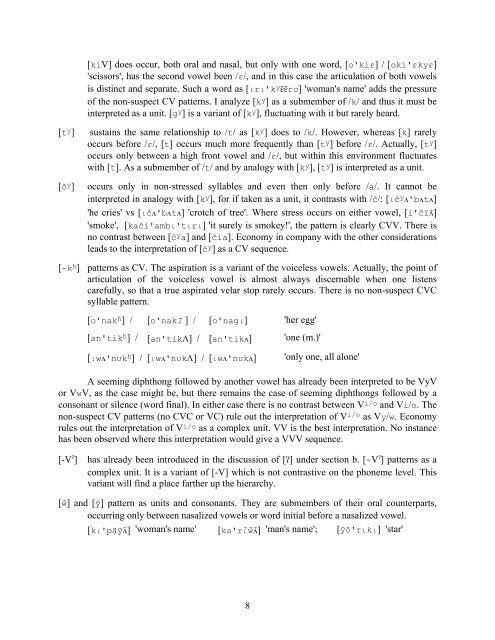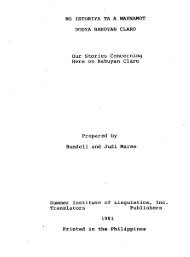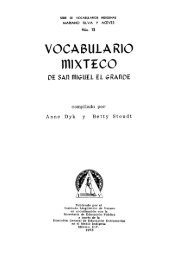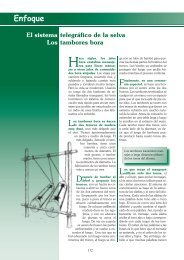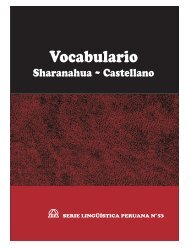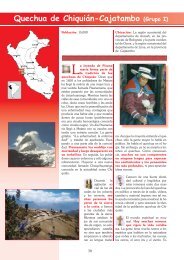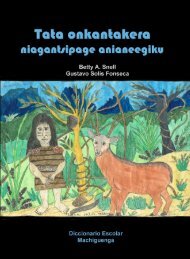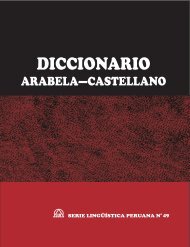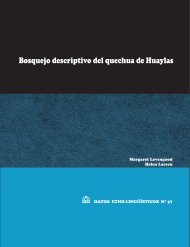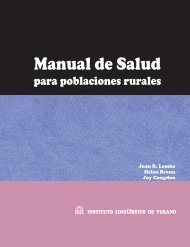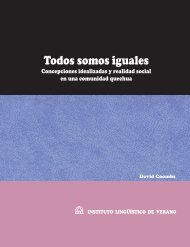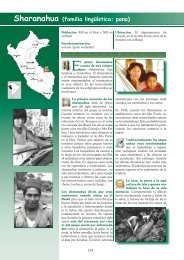A Phonemic Analysis of the Apurinã Language
A Phonemic Analysis of the Apurinã Language
A Phonemic Analysis of the Apurinã Language
You also want an ePaper? Increase the reach of your titles
YUMPU automatically turns print PDFs into web optimized ePapers that Google loves.
[kiV] does occur, both oral and nasal, but only with one word, [o'kiε] / [oki'εkyε]'scissors', has <strong>the</strong> second vowel been /ε/, and in this case <strong>the</strong> articulation <strong>of</strong> both vowelsis distinct and separate. Such a word as [ιrι'k y ɛ̃ɛ̃ro] 'woman's name' adds <strong>the</strong> pressure<strong>of</strong> <strong>the</strong> non-suspect CV patterns. I analyze [k y ] as a submember <strong>of</strong> /k/ and thus it must beinterpreted as a unit. [g y ] is a variant <strong>of</strong> [k y ], fluctuating with it but rarely heard.[t y ] sustains <strong>the</strong> same relationship to /t/ as [k y ] does to /k/. However, whereas [k] rarelyoccurs before /ε/, [t] occurs much more frequently than [t y ] before /ε/. Actually, [t y ]occurs only between a high front vowel and /ε/, but within this environment fluctuateswith [t]. As a submember <strong>of</strong> /t/ and by analogy with [k y ], [t y ] is interpreted as a unit.[č y ] occurs only in non-stressed syllables and even <strong>the</strong>n only before /a/. It cannot beinterpreted in analogy with [k y ], for if taken as a unit, it contrasts with /č/: [ιč y ʌ'bʌtʌ]'he cries' vs [ιčʌ'bʌtʌ] 'crotch <strong>of</strong> tree'. Where stress occurs on ei<strong>the</strong>r vowel, [i'čĩʌ̃]'smoke', [kači'ambι'tιrι] 'it surely is smokey!', <strong>the</strong> pattern is clearly CVV. There isno contrast between [č y a] and [čia]. Economy in company with <strong>the</strong> o<strong>the</strong>r considerationsleads to <strong>the</strong> interpretation <strong>of</strong> [č y ] as a CV sequence.[-k h ] patterns as CV. The aspiration is a variant <strong>of</strong> <strong>the</strong> voiceless vowels. Actually, <strong>the</strong> point <strong>of</strong>articulation <strong>of</strong> <strong>the</strong> voiceless vowel is almost always discernable when one listenscarefully, so that a true aspirated velar stop rarely occurs. There is no non-suspect CVCsyllable pattern.[o'nak h ] / [o'nakΙ ] / [o'nagι] 'her egg'[an'tik h ] / [an'tikɅ] / [an'tikʌ]'one (m.)'[ιwʌ'nυk h ] / [ιwʌ'nυkɅ] / [ιwʌ'nυkʌ]'only one, all alone'A seeming diphthong followed by ano<strong>the</strong>r vowel has already been interpreted to be VyVor VwV, as <strong>the</strong> case might be, but <strong>the</strong>re remains <strong>the</strong> case <strong>of</strong> seeming diphthongs followed by aconsonant or silence (word final). In ei<strong>the</strong>r case <strong>the</strong>re is no contrast between V i/o and Vi/o. Thenon-suspect CV patterns (no CVC or VC) rule out <strong>the</strong> interpretation <strong>of</strong> V i/o as Vy/w. Economyrules out <strong>the</strong> interpretation <strong>of</strong> V i/o as a complex unit. VV is <strong>the</strong> best interpretation. No instancehas been observed where this interpretation would give a VVV sequence.[-V ʔ ] has already been introduced in <strong>the</strong> discussion <strong>of</strong> [ʔ] under section b. [-V ʔ ] patterns as acomplex unit. It is a variant <strong>of</strong> [-V] which is not contrastive on <strong>the</strong> phoneme level. Thisvariant will find a place far<strong>the</strong>r up <strong>the</strong> hierarchy.[w̃] and [ỹ] pattern as units and consonants. They are submembers <strong>of</strong> <strong>the</strong>ir oral counterparts,occurring only between nasalized vowels or word initial before a nasalized vowel.[kι'pãỹʌ̃] 'woman's name' [ka'rι̃w̃ʌ̃] 'man's name'; [ỹõ'rιkι] 'star'8


